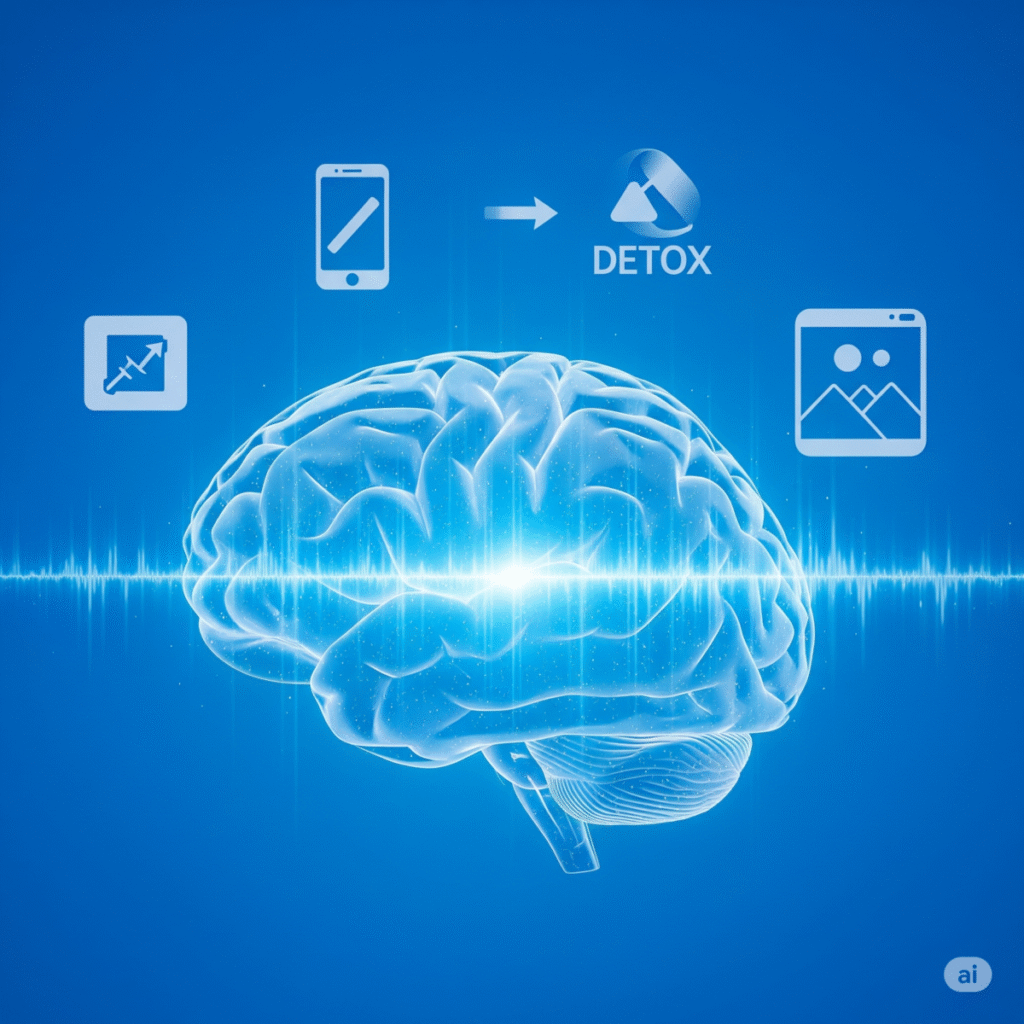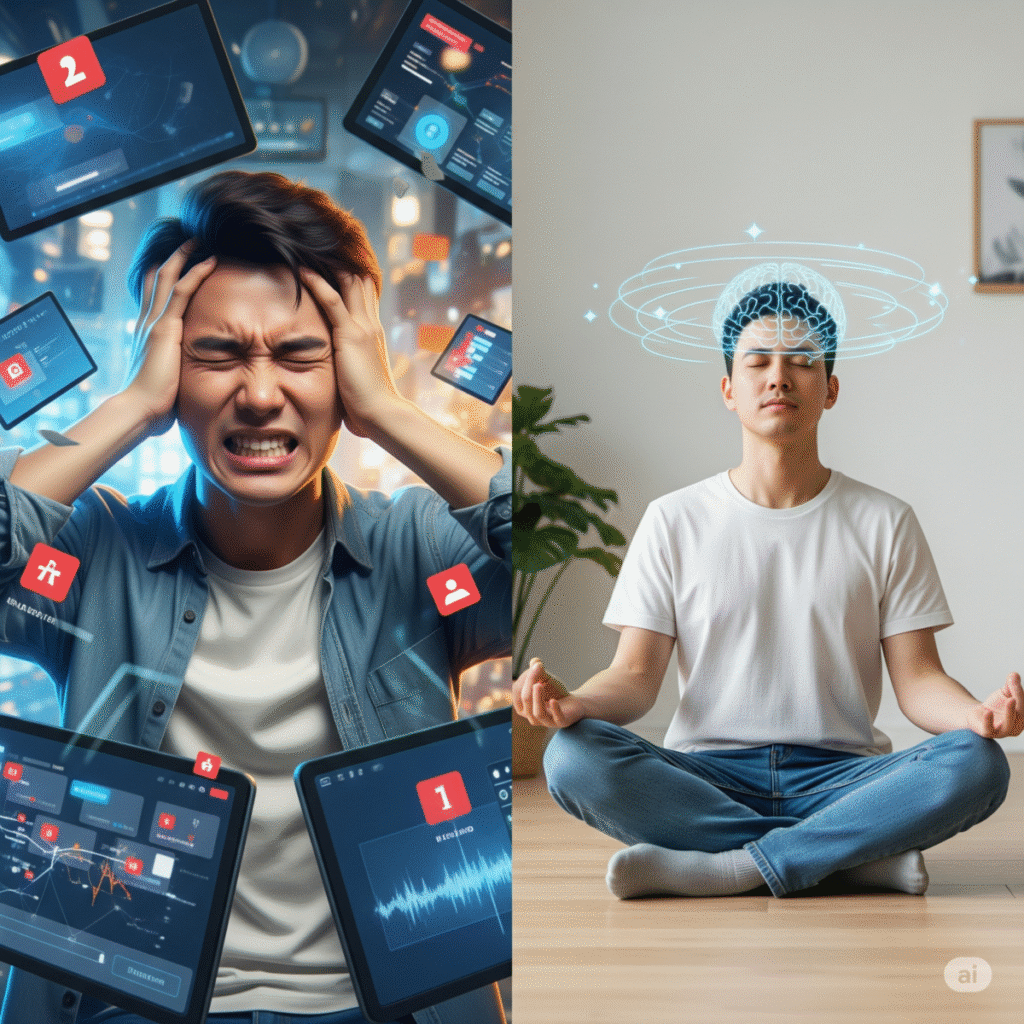Dopamine detox for focus is a powerful strategy to regain your mental clarity and boost productivity—without quitting your life completely.
In today’s world of endless notifications and short-form content, many of us are unknowingly caught in a dopamine loop. But the solution isn’t to quit everything. A realistic dopamine detox for productivity focuses on balance—identifying high-stimulation triggers, reducing impulsive habits, and developing mindfulness. This is your dopamine reset plan for the modern world.
The average person checks their phone 96 times daily, yet extreme dopamine detox advocates suggest going weeks without any digital stimulation. Here’s the truth: you don’t need to live like a monk to regain your focus. Instead, strategic dopamine discipline can transform your productivity without sacrificing the conveniences and connections that enrich your life.
What is Dopamine Detox for Focus?
Dopamine isn’t just the “pleasure chemical”—it’s your brain’s motivation and reward system. When you receive a text notification, complete a level in a mobile game, or scroll through social media, your brain releases dopamine in anticipation of reward. This creates what neuroscientists call a “seeking behavior loop.”
The problem isn’t dopamine itself—it’s the constant, unpredictable rewards from digital devices that hijack this natural system. Your brain becomes conditioned to seek these micro-hits of stimulation, making it increasingly difficult to focus on tasks that require sustained attention, like deep work, reading, or meaningful conversations.
Research from Stanford University shows that heavy multitaskers have reduced density in the anterior cingulate cortex, the brain region responsible for attention control. This neuroplasticity means your brain literally reshapes itself based on your habits—but the good news is that it can reshape itself back.
When you learn how to control impulsive habits, you’re essentially retraining your reward pathways. This doesn’t require eliminating all sources of pleasure, but rather creating intentional boundaries around high-stimulation activities.
The Science Behind Dopamine Dysregulation
Understanding the neuroscience behind dopamine dysfunction helps explain why a traditional dopamine detox often fails. Dr. Anna Lembke’s research at Stanford reveals that our brains maintain homeostasis through a delicate balance of pleasure and pain. When we consume too much high-dopamine content, our brains compensate by reducing baseline dopamine levels, leading to anhedonia—the inability to feel pleasure from normal activities.
This explains why checking social media feels rewarding in the moment but leaves you feeling empty afterward. Your dopamine receptors become desensitized, requiring increasingly stimulating content to achieve the same satisfaction. A strategic dopamine detox works by gradually resensitizing these receptors without completely depriving yourself of necessary digital tools.

How Dopamine Detox for Focus Improves Productivity
Social media is filled with stories of people who quit all technology, entertainment, and pleasurable activities for 30, 60, or even 90 days. While these extreme approaches might work for some, they’re often unsustainable and unnecessary for most people.
The “all-or-nothing” mentality around dopamine detoxing can actually backfire. When you completely restrict yourself from normal modern conveniences, you’re setting up a cycle of deprivation and binging that mirrors unhealthy diet behaviors. Additionally, completely disconnecting from digital tools can harm your professional relationships, social connections, and access to valuable information.
True dopamine discipline isn’t about punishment—it’s about optimization. Instead of eliminating dopamine-triggering activities entirely, the goal is to consume them more intentionally and reduce their interference with your priorities.
Consider this: a chef doesn’t stop using salt to create healthier meals—they learn to use it strategically. Similarly, a realistic dopamine detox teaches you to use stimulating activities as tools rather than letting them use you.
Why Extreme Approaches Fail Long-Term
Psychological research demonstrates that extreme restriction often leads to what experts call the “forbidden fruit effect.” When something is completely off-limits, it becomes more psychologically appealing. This is why people who attempt radical dopamine detoxes often experience intense cravings and eventual relapse into even more compulsive behaviors.
A successful dopamine detox strategy acknowledges that we live in a digital world and focuses on developing a healthier relationship with technology rather than avoiding it entirely. This approach builds sustainable habits that improve focus without creating unnecessary stress or social isolation.
Steps to Start Your Dopamine Detox for Focus Today
Your dopamine reset plan should fit into your actual life, not require you to abandon it. Here’s a framework that focuses on gradual changes and sustainable habits rather than dramatic lifestyle overhauls.
Daily Schedule for a Light Dopamine Detox
Morning (First 90 Minutes)
- Keep your phone in airplane mode or another room
- Begin with 5-10 minutes of deep breathing or light stretching
- Eat breakfast mindfully without screens
- Review your three most important tasks for the day
Midday Reset (15-30 Minutes)
- Take a walk without podcasts or music
- Practice the “5-4-3-2-1” grounding technique: notice 5 things you see, 4 you hear, 3 you feel, 2 you smell, 1 you taste
- Drink water and take five deep breaths before returning to work
Evening Wind-Down (60-90 Minutes Before Bed)
- Set devices to “Do Not Disturb” or charge them outside the bedroom
- Engage in analog activities: reading physical books, journaling, gentle yoga, or conversation
- Prepare for tomorrow by laying out clothes and reviewing your schedule
This schedule creates natural dopamine regulation points throughout your day without requiring you to give up essential digital tools or entertainment entirely.
Weekly Dopamine Detox Progression
Building on the daily routine, implement a progressive weekly structure that gradually increases your tolerance for delayed gratification:
Week 1: Foundation Building
- Focus on morning phone-free time
- Establish one 30-minute focused work block daily
- Practice mindful eating for one meal per day
Week 2: Expanding Boundaries
- Add evening digital sunset routine
- Increase focused work blocks to 45 minutes
- Introduce weekend morning walks without devices
Week 3: Deepening Practice
- Implement notification batching (check 3-4 times daily)
- Practice 60-minute deep work sessions
- Try one completely screen-free evening per week
Week 4: Integration and Mastery
- Establish 90-minute morning routine without devices
- Maintain consistent digital boundaries across weekends
- Practice urge surfing when impulses arise
Small Digital Breaks vs. Complete Unplugging
Instead of going completely offline, try “digital fasting windows”—specific times when you’re intentionally offline. Start with just 30-60 minutes and gradually increase:
Week 1: 30 minutes in the morning
Week 2: Add 30 minutes before bed
Week 3: Include 1 hour during your peak focus time
Week 4: Extend to 90-minute focused work blocks
During these windows, keep your phone in another room or use app-blocking software. The key is consistency rather than duration—it’s better to maintain 30 minutes daily than to do 3-hour sessions sporadically.

Scientific Backing Behind Dopamine Detox for Focus
The goal of dopamine discipline isn’t to eliminate pleasure from your life—it’s to ensure that your impulses align with your values and long-term goals. Here are practical strategies that maintain life satisfaction while building self-control.
Replace the phrase “I can’t” with “I don’t” when declining impulsive behaviors. Research from Boston College shows that “I don’t” creates a sense of identity and personal standards, while “I can’t” implies temporary restriction. For example, “I don’t check social media during work hours” is more effective than “I can’t check social media right now.”
Create “friction” for impulsive behaviors by adding small barriers. Log out of social media accounts, remove apps from your home screen, or use website blockers during focused work time. Simultaneously, reduce friction for beneficial behaviors by keeping books visible, preparing healthy snacks in advance, or laying out exercise clothes.
Advanced Impulse Control Techniques
The SPACE Method
- Stop: Pause when you notice an impulse
- Physical awareness: Notice bodily sensations
- Acknowledge: Accept the feeling without judgment
- Curiosity: Explore what triggered this impulse
- Engage: Choose a response aligned with your values
Environmental Design for Success Your physical environment significantly impacts your ability to maintain dopamine discipline. Create spaces that naturally support focused behavior:
- Designate phone-free zones in your home
- Use physical books instead of e-readers when possible
- Keep analog alternatives visible (notebooks, puzzles, art supplies)
- Create a dedicated workspace free from entertainment devices
Dopamine Discipline in Daily Routines
Build structured “dopamine breaks” into your schedule—designated times for checking messages, browsing social media, or engaging in other stimulating activities. This prevents constant interruption while ensuring you don’t feel deprived.
Try the “10-10-10 Rule” for impulse control: When you feel the urge to engage in a potentially distracting behavior, ask yourself how you’ll feel about this choice in 10 minutes, 10 months, and 10 years. This creates space between impulse and action.
Practice “urge surfing”—when you feel a strong impulse, notice it without immediately acting. Set a timer for 2-3 minutes and observe how the urge changes in intensity. Often, the urge will naturally diminish if you don’t feed it with action.
Dopamine Detox for Productivity at Work
Your workplace doesn’t need to become a monastery for you to implement effective dopamine discipline. These strategies work within professional environments while significantly improving focus and output.
Time-Blocking with Digital Boundaries: Schedule specific times for checking email and messages rather than maintaining constant availability. Most professionals find that checking email 3-4 times daily is sufficient and dramatically improves deep work capacity.
The Two-Browser System: Use one browser for work-related activities and another for personal browsing. This creates a clear boundary and reduces the likelihood of accidentally falling into social media or news during work hours.
Notification Triage: Turn off all non-essential notifications during work hours. Keep only truly urgent communication channels active, such as direct calls or messages from your immediate supervisor.According to Healthline’s research on dopamine fasting, strategic detoxing can help reduce brain fatigue.Struggling with anxiety while trying to regain your focus? Along with a dopamine detox, managing anxiety naturally can significantly boost your mental clarity. Learn more about natural anxiety relief techniques here to support your journey toward a calmer, more focused mind.
You can also explore this scientific study from NCBI on dopamine’s role in behavioral focus.
Environmental Design: Arrange your workspace to support focus. Keep your phone in a drawer or bag, use website blockers during deep work sessions, and have a physical notebook for capturing random thoughts without switching to digital devices.
Micro-Breaks for Dopamine Regulation: Instead of scrolling social media during breaks, try brief walks, stretching, or looking out a window. These activities provide mental rest without triggering the seeking behavior loop that makes it difficult to return to focused work.
Professional Dopamine Detox Strategies
The Pomodoro Plus Method Enhance traditional Pomodoro technique with dopamine-conscious breaks:
- 25 minutes focused work (no digital distractions)
- 5-minute analog break (walk, stretch, breathe)
- After 4 cycles, take a 15-30 minute nature break
- Schedule digital check-ins only during longer breaks
Meeting Mindfulness Transform meetings into dopamine detox opportunities:
- Keep phones in bags or drawers during meetings
- Take handwritten notes instead of digital ones
- Practice active listening without multitasking
- Suggest walking meetings when appropriate

Real Stories: I Quit Dopamine Detoxing—And Got More Done
Many people who’ve tried extreme dopamine detoxes report better results from moderate, sustainable approaches. Here are patterns from individuals who found success with realistic dopamine discipline:
Sarah, Marketing Manager: “I tried a 30-day digital detox and lasted four days. Then I switched to keeping my phone in another room during morning work blocks. Six months later, I’ve completed two major projects that I’d been procrastinating on for years.”
Mike, Software Developer: “Complete social media elimination made me feel isolated from my professional community. Now I batch social media to 15 minutes at lunch and 15 minutes after dinner. I’m still connected but not constantly distracted.”
Jennifer, Graduate Student: “I realized that my ‘dopamine detox’ was just another form of procrastination. Instead of avoiding my thesis by scrolling, I was avoiding it by rigidly controlling every minute of my day. Learning to work with my natural impulses instead of fighting them completely changed my productivity.”
David, Entrepreneur: “The extreme dopamine detox approach made me feel like I was missing out on industry trends and networking opportunities. I found success with ‘conscious consumption’—setting specific times for business-related social media and completely avoiding entertainment platforms during work hours. My focus improved dramatically while maintaining professional connections.”
The common thread in these experiences is finding balance rather than elimination. Dopamine discipline becomes sustainable when it enhances your life rather than restricting it.
Advanced Dopamine Detox Techniques
Neuroplasticity and Habit Formation
Understanding how your brain forms new neural pathways can accelerate your dopamine detox progress. Research shows that it takes approximately 66 days to form a new habit, but you can see significant changes in focus and impulse control within two weeks of consistent practice.
Progressive Difficulty Training Start with easy wins and gradually increase challenges:
- Day 1-7: Replace one high-stimulation activity with a low-stimulation alternative
- Day 8-14: Add structured digital fasting windows
- Day 15-21: Implement deeper work sessions with zero digital interruptions
- Day 22+: Maintain consistency while fine-tuning based on results
Mindfulness Integration Combine dopamine detox practices with mindfulness meditation to strengthen your awareness of impulses:
- Practice 10-minute daily meditation focusing on breath awareness
- Use mindful transitions between activities instead of reaching for devices
- Develop meta-cognitive awareness of your thought patterns and triggers

FAQ: How Long Does a Dopamine Reset Take?
Q: How quickly will I see results from a dopamine detox for productivity? A: Most people notice improved focus within 3-7 days of implementing consistent boundaries around high-stimulation activities. However, significant changes in attention span and impulse control typically develop over 2-4 weeks of consistent practice.
Q: Can I still use my phone and computer during a dopamine reset? A: Absolutely. A realistic dopamine detox involves using technology intentionally rather than avoiding it completely. The goal is to reduce impulsive, mindless usage while maintaining necessary digital tools.A healthy gut plays a crucial role in maintaining overall mental focus and clarity. If you’re working on improving your concentration through dopamine detox, don’t ignore your digestion. Discover how ancient Ayurveda can naturally support digestive health and boost your brain-body connection.
Q: What if I work in a job that requires constant digital connectivity? A: Focus on creating boundaries within your digital usage. Use scheduled check-ins for non-urgent communications, turn off unnecessary notifications, and practice single-tasking even while using digital tools.
Q: Is it normal to feel anxious when starting dopamine discipline practices? A: Yes, mild anxiety or restlessness is common in the first few days as your brain adjusts to lower levels of constant stimulation. This typically subsides as you develop new habits and your attention system recalibrates.
Q: How do I handle social pressure to be constantly available? A: Communicate your boundaries clearly and proactively. Let colleagues and friends know your communication schedule, and stick to it consistently. Most people respect clear boundaries more than they respect inconsistent availability.
Q: What’s the difference between a dopamine detox and digital minimalism? A: While both approaches aim to improve your relationship with technology, a dopamine detox specifically focuses on resetting your brain’s reward system and improving focus. Digital minimalism is broader, encompassing intentional technology use for overall life satisfaction.
Final Thoughts: You Don’t Need to Quit Everything to Regain Focus
When you learn how to control impulsive habits, you regain control of your time, energy, and focus. Instead of a 30-day tech fast, try scheduling small screen-free blocks and replacing doomscrolling with deep breathing, walking, or journaling. These micro-habits are the foundation of dopamine discipline—not deprivation, but transformation.
The most effective dopamine reset plan is one you can maintain long-term. Rather than viewing dopamine detox as a temporary intervention, think of it as developing a healthier relationship with stimulation and reward. Your brain is remarkably adaptable—small, consistent changes in your daily habits can create significant improvements in focus, productivity, and overall well-being.
Remember that the goal isn’t to eliminate dopamine or pleasure from your life. Dopamine is essential for motivation, learning, and enjoyment. The objective is to ensure that your dopamine system works for you rather than against you, supporting your goals and values instead of undermining them.
A successful dopamine detox strategy recognizes that we live in an interconnected world where complete digital abstinence is neither practical nor necessary. The key is developing intentional consumption habits that align with your priorities and values.
Start small, be consistent, and adjust the approach based on what works for your unique lifestyle and responsibilities. A realistic dopamine detox for productivity isn’t about perfection—it’s about progress toward a more intentional, focused way of living. Whether you’re dealing with social media addiction, email overwhelm, or general digital distraction, the principles remain the same: create boundaries, build awareness, and practice patience with the process.
The journey toward better dopamine discipline is ultimately about reclaiming your attention—your most valuable resource in an increasingly distracted world. By implementing these strategies gradually and consistently, you’ll develop the focus and mental clarity needed to pursue your most important goals while still enjoying the benefits of modern technology.
🧠 Transform Your Health, One Habit at a Time
Don’t miss our weekly insights into brain health, dopamine detox, and emotional mastery.
📬 Subscribe to the Health Morph Newsletter for science-backed tips and habit strategies that work in real life.
🎥 Watch & Learn: Subscribe to our Health Morph YouTube Channel for visual guides, brain hacks, and more!
👉 Join thousands who are turning chaos into clarity.
The average person checks their phone 96 times daily, yet extreme dopamine detox advocates suggest going weeks without any digital stimulation. Here’s the truth: you don’t need to live like a monk to regain your focus. Instead, strategic dopamine discipline can transform your productivity without sacrificing the conveniences and connections that enrich your life.
What Is Dopamine and Why It Affects Your Focus
Dopamine isn’t just the “pleasure chemical”—it’s your brain’s motivation and reward system. When you receive a text notification, complete a level in a mobile game, or scroll through social media, your brain releases dopamine in anticipation of reward. This creates what neuroscientists call a “seeking behavior loop.”
The problem isn’t dopamine itself—it’s the constant, unpredictable rewards from digital devices that hijack this natural system. Your brain becomes conditioned to seek these micro-hits of stimulation, making it increasingly difficult to focus on tasks that require sustained attention, like deep work, reading, or meaningful conversations.
Research from Stanford University shows that heavy multitaskers have reduced density in the anterior cingulate cortex, the brain region responsible for attention control. This neuroplasticity means your brain literally reshapes itself based on your habits—but the good news is that it can reshape itself back.
When you learn how to control impulsive habits, you’re essentially retraining your reward pathways. This doesn’t require eliminating all sources of pleasure, but rather creating intentional boundaries around high-stimulation activities.
The Myth of Extreme Dopamine Detoxing
Social media is filled with stories of people who quit all technology, entertainment, and pleasurable activities for 30, 60, or even 90 days. While these extreme approaches might work for some, they’re often unsustainable and unnecessary for most people.
The “all-or-nothing” mentality around dopamine detoxing can actually backfire. When you completely restrict yourself from normal modern conveniences, you’re setting up a cycle of deprivation and binging that mirrors unhealthy diet behaviors. Additionally, completely disconnecting from digital tools can harm your professional relationships, social connections, and access to valuable information.
True dopamine discipline isn’t about punishment—it’s about optimization. Instead of eliminating dopamine-triggering activities entirely, the goal is to consume them more intentionally and reduce their interference with your priorities.
Consider this: a chef doesn’t stop using salt to create healthier meals—they learn to use it strategically. Similarly, a realistic dopamine detox teaches you to use stimulating activities as tools rather than letting them use you.
Dopamine Reset Plan — Realistic, Not Radical
Your dopamine reset plan should fit into your actual life, not require you to abandon it. Here’s a framework that focuses on gradual changes and sustainable habits rather than dramatic lifestyle overhauls.
Daily Schedule for a Light Dopamine Detox
Morning (First 90 Minutes)
- Keep your phone in airplane mode or another room
- Begin with 5-10 minutes of deep breathing or light stretching
- Eat breakfast mindfully without screens
- Review your three most important tasks for the day
Midday Reset (15-30 Minutes)
- Take a walk without podcasts or music
- Practice the “5-4-3-2-1” grounding technique: notice 5 things you see, 4 you hear, 3 you feel, 2 you smell, 1 you taste
- Drink water and take five deep breaths before returning to work
Evening Wind-Down (60-90 Minutes Before Bed)
- Set devices to “Do Not Disturb” or charge them outside the bedroom
- Engage in analog activities: reading physical books, journaling, gentle yoga, or conversation
- Prepare for tomorrow by laying out clothes and reviewing your schedule
This schedule creates natural dopamine regulation points throughout your day without requiring you to give up essential digital tools or entertainment entirely.
Small Digital Breaks vs. Complete Unplugging
Instead of going completely offline, try “digital fasting windows”—specific times when you’re intentionally offline. Start with just 30-60 minutes and gradually increase:
Week 1: 30 minutes in the morning Week 2: Add 30 minutes before bed Week 3: Include 1 hour during your peak focus time Week 4: Extend to 90-minute focused work blocks
During these windows, keep your phone in another room or use app-blocking software. The key is consistency rather than duration—it’s better to maintain 30 minutes daily than to do 3-hour sessions sporadically.
How to Control Impulsive Habits Without Losing Joy
The goal of dopamine discipline isn’t to eliminate pleasure from your life—it’s to ensure that your impulses align with your values and long-term goals. Here are practical strategies that maintain life satisfaction while building self-control.
Replace the phrase “I can’t” with “I don’t” when declining impulsive behaviors. Research from Boston College shows that “I don’t” creates a sense of identity and personal standards, while “I can’t” implies temporary restriction. For example, “I don’t check social media during work hours” is more effective than “I can’t check social media right now.”
Create “friction” for impulsive behaviors by adding small barriers. Log out of social media accounts, remove apps from your home screen, or use website blockers during focused work time. Simultaneously, reduce friction for beneficial behaviors by keeping books visible, preparing healthy snacks in advance, or laying out exercise clothes.
Dopamine Discipline in Daily Routines
Build structured “dopamine breaks” into your schedule—designated times for checking messages, browsing social media, or engaging in other stimulating activities. This prevents constant interruption while ensuring you don’t feel deprived.
Try the “10-10-10 Rule” for impulse control: When you feel the urge to engage in a potentially distracting behavior, ask yourself how you’ll feel about this choice in 10 minutes, 10 months, and 10 years. This creates space between impulse and action.
Practice “urge surfing”—when you feel a strong impulse, notice it without immediately acting. Set a timer for 2-3 minutes and observe how the urge changes in intensity. Often, the urge will naturally diminish if you don’t feed it with action.
Dopamine Detox for Productivity at Work
Your workplace doesn’t need to become a monastery for you to implement effective dopamine discipline. These strategies work within professional environments while significantly improving focus and output.
Time-Blocking with Digital Boundaries: Schedule specific times for checking email and messages rather than maintaining constant availability. Most professionals find that checking email 3-4 times daily is sufficient and dramatically improves deep work capacity.
The Two-Browser System: Use one browser for work-related activities and another for personal browsing. This creates a clear boundary and reduces the likelihood of accidentally falling into social media or news during work hours.
Notification Triage: Turn off all non-essential notifications during work hours. Keep only truly urgent communication channels active, such as direct calls or messages from your immediate supervisor.
Environmental Design: Arrange your workspace to support focus. Keep your phone in a drawer or bag, use website blockers during deep work sessions, and have a physical notebook for capturing random thoughts without switching to digital devices.
Micro-Breaks for Dopamine Regulation: Instead of scrolling social media during breaks, try brief walks, stretching, or looking out a window. These activities provide mental rest without triggering the seeking behavior loop that makes it difficult to return to focused work.
Real Stories: I Quit Dopamine Detoxing—And Got More Done
Many people who’ve tried extreme dopamine detoxes report better results from moderate, sustainable approaches. Here are patterns from individuals who found success with realistic dopamine discipline:
Sarah, Marketing Manager: “I tried a 30-day digital detox and lasted four days. Then I switched to keeping my phone in another room during morning work blocks. Six months later, I’ve completed two major projects that I’d been procrastinating on for years.”
Mike, Software Developer: “Complete social media elimination made me feel isolated from my professional community. Now I batch social media to 15 minutes at lunch and 15 minutes after dinner. I’m still connected but not constantly distracted.”
Jennifer, Graduate Student: “I realized that my ‘dopamine detox’ was just another form of procrastination. Instead of avoiding my thesis by scrolling, I was avoiding it by rigidly controlling every minute of my day. Learning to work with my natural impulses instead of fighting them completely changed my productivity.”
The common thread in these experiences is finding balance rather than elimination. Dopamine discipline becomes sustainable when it enhances your life rather than restricting it.
Frequently Asked Questions (FAQs)
1. What is dopamine detox for focus?
Dopamine detox for focus is a mental reset technique where individuals temporarily avoid stimulating activities like social media, gaming, or junk food to rebalance their brain’s reward system and improve concentration.
2. How does dopamine detox improve focus?
By reducing overstimulation, dopamine detox helps the brain become more sensitive to natural rewards, making it easier to focus on tasks without seeking constant external gratification.
3. How long should a dopamine detox last?
It can last from a few hours to a full day or longer. Most people start with 4–24 hours of avoiding high-dopamine activities.
4. Do I have to quit everything during a dopamine detox?
No, you only avoid high-stimulation triggers. Calmer activities like journaling and walking are encouraged.
5. Is dopamine detox scientifically proven?
While the term itself isn’t clinical, the idea of reducing overstimulation to improve mental clarity is supported by neuroscience research.
6. Can dopamine detox help with productivity?
Yes, regular detoxing can help increase productivity, reduce distraction, and improve your ability to focus deeply.
Final Thoughts: You Don’t Need to Quit Everything to Regain Focus
When you learn how to control impulsive habits, you regain control of your time, energy, and focus. Instead of a 30-day tech fast, try scheduling small screen-free blocks and replacing doomscrolling with deep breathing, walking, or journaling. These micro-habits are the foundation of dopamine discipline—not deprivation, but transformation.
The most effective dopamine reset plan is one you can maintain long-term. Rather than viewing dopamine detox as a temporary intervention, think of it as developing a healthier relationship with stimulation and reward. Your brain is remarkably adaptable—small, consistent changes in your daily habits can create significant improvements in focus, productivity, and overall well-being.
Remember that the goal isn’t to eliminate dopamine or pleasure from your life. Dopamine is essential for motivation, learning, and enjoyment. The objective is to ensure that your dopamine system works for you rather than against you, supporting your goals and values instead of undermining them.
Start small, be consistent, and adjust the approach based on what works for your unique lifestyle and responsibilities. A realistic dopamine detox for productivity isn’t about perfection—it’s about progress toward a more intentional, focused way of living.
🧠 Transform Your Health, One Habit at a Time
Don’t miss our weekly insights into brain health, dopamine detox, and emotional mastery.
📬 Subscribe to the Health Morph Newsletter for science-backed tips and habit strategies that work in real life.
🎥 Watch & Learn: Subscribe to our Health Morph YouTube Channel for visual guides, brain hacks, and more!
👉 Join thousands who are turning chaos into clarity.
Written by: Parvez Ali
Medically reviewed by: Dr. Ayesha Khan, MD
Edited by: Ravi Mehra, Senior Editor
Published on July 28, 2025






Leave a Reply